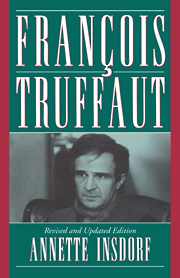Book contents
3 - Renoirian Vision
Summary
From Renoir to Antoine Doinel
IN HIS INTRODUCTION to André Bazin's Jean Renoir, Truffaut writes,
I am not far from thinking that the work of Jean Renoir is the work of an infallible film maker. To be less extravagant, I will say that Renoir's work has always been guided by a philosophy of life which expresses itself with the aid of something much like a trade secret: sympathy. It is thanks to this sympathy that Renoir has succeeded in creating the most alive films in the history of the cinema, films which breathe forty years after they were made. (pp. 8–9)
This comment lends itself to what is perhaps the most striking and engaging aspect of Truffaut's own work. Both directors form part of the “lyrical” tradition of French cinema, suffusing their often dark visions with warmth and humor. The sympathy that one feels in their work derives in part from the attitude of the director toward his subject matter, characters, actors, and medium; beyond choices of script and casting, these attitudes are expressed through camera placement, camera movement, and montage. There is implicit affection in certain uses of the close-up, pan, or long take in the way that we are brought closer to the characters, moving and remaining with them longer.
For younger filmmakers like Truffaut, Renoir's films provided an ongoing lesson in the primacy of the imperfect individual. It is difficult to find either “heroes” or “villains” in his work—or in films like Stolen Kisses, Bed and Board, and Day for Night.
- Type
- Chapter
- Information
- François Truffaut , pp. 69 - 104Publisher: Cambridge University PressPrint publication year: 1995



